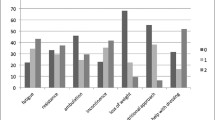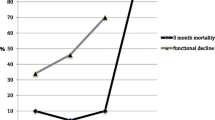Abstract
Background/Objectives
To investigate the predictive validity of the short, simple FRAIL-NH frailty screening tool in the long term care population and to then compare the predictive validity with the frailty index (FI) for 6-month adverse health outcomes.
Design
Retrospective study using the Minimum Data Set (MDS) 3.0 and chart review from June-December 2014.
Setting
Two Long Term Care Facilities in Saint Louis, MO.
Participants
270 patients ages ≥ 65 years old residing in long term care.
Measurements
Frailty was measured using the FRAIL-NH and Frailty Index (FI) criteria. Adverse outcomes measured at 6-month follow-up included falls, hospitalizations, and hospice enrollment/mortality.
Results
Based on screening tool used frailty prevalence was 48.7% for FRAIL-NH and 30.3% for FI. The FRAIL-NH pre-frail (Adjusted Odds Ratio [AOR]=2.62; 95% Confidence Interval [CI]=1.25–5.54; p=0.11) classification was associated with 6 month risk of falling and mortality/hospice enrollment was associated with the frail classification, AOR=3.96 (1.44–10.87, p=0.007). Combining the pre-frail and frail categories both measures predicted 6 month mortality with the FRAIL-NH being the strongest predictor (AOR=3.36; 95%CI=1.26–8.98; p=0.016) and the FI was a more modest predictor with an AOR of 2.28; 95%CI=1.01–5.15; p=0.047. When directly comparing the FRAIL-NH to the FI, the FRAIL-NH pre-frail were at increased risk of falling, AOR=2.42 (1.11–5.92, p=0.027) and the FRAIL-NH frail were at increased risk of hospice enrollment/death, OR=3.25 (1.04–10.86) p=0.044.
Conclusion
In comparison to the FI, the FRAIL-NH preformed just as well at screening for frailty and was a slightly better predictor of adverse outcomes. The FRAIL-NH is a brief, easy-to-administer frailty screening tool appropriate for long term care patients and predicts increased risk of falls in the pre-frail and mortality/hospice enrollment in the frail.
Similar content being viewed by others
References
Collard RM, Boter H, Schoevers RA, et al. Prevalence of Frailty in Community-Dwelling Older Persons: A Systematic Review. Journal of the American Geriatrics Society, 60(8), 1487-1492.
González-Vaca J, de la Rica-Escuin M, Silva-Iglesias M, et al. Frailty in institutionalized older adults from Albacete. The FINAL study: Rationale, design methodology, prevalence and attributes. Maturitas 2014;77:78–84.
Kanwar A, Singh M, Lennon R, et al. Frailty and health-related quality of life among residents of long-term care facilities. J Aging Health 2013;25:792–802.
Matusik P, Tomaszewski K, Schmielowska K, et al. Severe frailty and cognitive impairment are related to higher mortality in 12-month follow-up of nursing home residents. Arch Gerontol Geriatr 2012;55:22–24.
Fried, LP, Hadley, EC, Walston, JD, et al. From bedside to bench: research agenda for frailty. Science’s SAGE KE, 2005(31), pe24.
Fried LP, Tangen CM, Walston J, et al, Cardiovascular Health Study Collaborative Research Group. Frailty in older adults: Evidence for a phenotype. J Gerontol A Biol Sci Med Sci 2001;56:M146–M156.
Rockwood K, & Mitnitski A Frailty in relation to the accumulation of deficits. The Journals of Gerontology Series A: Biological Sciences and Medical Sciences, 2007;62(7), 722–727.
Abellan van Kan G, Rolland YM, Morley JE, Vellas B. Frailty: Toward a clinical definition. J Am Med Dir Assoc 2008;9:71–72.
Morley, JE, Malmstrom, TK, & Miller, DK. A simple frailty questionnaire (FRAIL) predicts outcomes in middle aged African Americans. The journal of nutrition, health & aging, 2013;16(7), 601–608.
Woo J, Leung J, & Morley JE. Comparison of frailty indicators based on clinical phenotype and the multiple deficit approach in predicting mortality and physical limitation. Journal of the American Geriatrics Society, 2012;60(8), 1478–1486.
Lopez D, Flicker L, & Dobson A. Validation of the frail scale in a cohort of older Australian women. Journal of the American Geriatrics Society, 2012;60(1), 171–173.
Malmstrom TK, Miller DK, & Morley JE. A comparison of frailty scales. J Am Geriatr Soc 2014;62:721–726.
Theou O, Brothers TD, Peña FG, et al. Identifying common characteristics of frailty across seven scales. Journal of the American Geriatrics Society, 2014;62(5), 901–906.
Theou O, Brothers TD, Mitnitski A, et al. Operationalization of Frailty Using Eight Commonly Used Scales and Comparison of Their Ability to Predict All-Cause Mortality. Journal of the American Geriatrics Society, 2013;61(9), 1537–1551.
Kaehr E, Visvanathan R. Malmstrom, TK, & Morley J. Frailty in Nursing Homes: The FRAIL-NH Scale. Journal of the American Medical Directors Association, 2015 16(2), 87.
Luo H, Lum Terry, Wong Gloria, et al. Predicting Adverse Outcomes in the Nursing Home: A 9-Year Longitudinal Study and Development of the FRAIL-Minimum Data et (MDS) Quick Screening Tool. Journal of the American Directors Association, 2015;16(12), 1042–1047.
Searle SD., Mitnitski A, Gahbauer E A, et al. A standard procedure for creating a frailty index. BMC geriatrics, 2008(1), 24.
Garrido M, Serrano MD, Bartolomé R, et al. Differences in the expression of the frailty syndrome in institutionalized elderly men and women with no severe cognitive decline Revista espanola de geriatria y gerontologia, 2001;47(6), 247–253.
Tabue-Teguo M, Kelaiditi E, Demougeot L, et al. Frailty index and mortality in nursing home residents in France: Results from the INCUR study. Journal of the American Medical Directors Association. 2015;16(7)603–606.
Theou O, Stathokostas L, Roland KP, et al. The effectiveness of exercise interventions for the management of frailty: a systematic review. Journal of aging research, 2011.
Morley JE. Urinary incontinence and the community-dwelling elder: A practical approach to diagnosis and management for the primary care geriatrician. Clin Geriatr Med 2004;20:427–435.
Chassagne P, Landrin I, Neveu C, et al. Fecal incontinence in the institutionalized elderly: incidence, risk factors, and prognosis. The American journal of medicine 1999 106(2), 185–190.
Lang T, Streeper T, Cawthon P, et al. Sarcopenia: etiology, clinical consequences, intervention, and assessment. Osteoporosis international, 2012;21(4), 543–559.
Fiatarone MA, O’Neill EF, Ryan ND, et al. Exercise training and nutritional supplementation for physical frailty in very elderly people. New England Journal of Medicine, 1994;330(25), 1769–1775.
Ng TP, Feng L, Nyunt MSZ, et al. Nutritional, physical, cognitive, and combination interventions and frailty reversal among older adults: a randomized controlled trial. The American journal of medicine, 2015 128(11), 1225–1236.
Ouslander JG, Bonner A, Herndon L, et al. The Intervention to Reduce Acute Care Transfers (INTERACT) quality improvement program: An overview for medical directors and primary care clinicians in long-term care. J Am Med Dir Assoc 2014;15:162–170.
Zheng NT, Mukamel DB., Friedman B, et al. The effect of hospice on hospitalizations of nursing home residents. Journal of the American Medical Directors Association, 2015;16(2), 155–159.
Author information
Authors and Affiliations
Corresponding authors
Rights and permissions
About this article
Cite this article
Kaehr, E.W., Pape, L.C., Malmstrom, T.K. et al. FRAIL-NH predicts outcomes in long term care. J Nutr Health Aging 20, 192–198 (2016). https://doi.org/10.1007/s12603-016-0682-5
Received:
Accepted:
Published:
Issue Date:
DOI: https://doi.org/10.1007/s12603-016-0682-5




